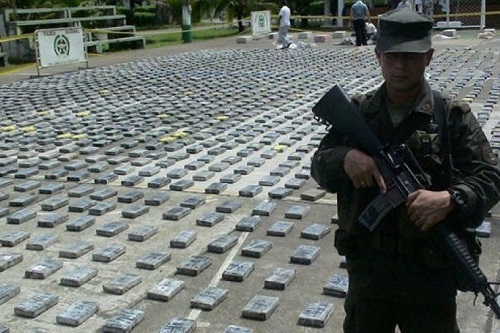AP photo
By
Ricardo Swire
Contrary to predictions of a “majority” shift to Caribbean drug trafficking routes, modern trends reinforce Central America as the main corridor for drug shipments delivered to USA’s 327 land, sea and air points of entry.
Since 1997 Coast Guard and maritime law enforcement units together intercepted no less than 806,469 pounds of cocaine, 333,285 pounds of marijuana, all transitory from South America via the Caribbean.
84% of the USA’s arriving cocaine passes through Central America, the transcontinental passageway accommodating a US$34 billion underground economy. Guatemala, Honduras and El Salvador form the “Northern Triangle,” a new explored frontier by Mexican cartels. Between 2008 and 2009 transnational Drug Trafficking Organizations (DTOs) began alternating routes, in response to effective law enforcement tactics or inter-cartel rivalry.
In March 2011 Honduras National Police counter-narcotics officers discovered the country’s first cocaine processing laboratory. The Sinaloa Cartel operated secret drug facility was situated on a coffee farm north of Tegucigalpa, the capital city. For three years the Mexican drug cartel manufactured one ton of cocaine per month in Honduras. Today Mexican drug cartels also control exclusive responsibility for transportation of Colombian cocaine moving north.
To avoid the US Southwest Border’s sweeping security dragnet DTOs opt for private maritime transport. Law enforcement drug confiscations from ships/boats are less than one percent of US Southwest Border’s land seizures. The ships move multi-ton consignments to America via Puerto Rico, South Florida, South Texas and southern California. Caribbean based DTO mariners mainly transfer consignments from the Dominican Republic, exploiting Puerto Rico and Florida’s coastlines.
In the first six months of 2016 drug seizure increased across Central America, especially in Guatemala and Panama. Between January 1, 2016 and July 24, 2016 Guatemala’s National Civil Police (PNC) intercepted 7,326 kilos of cocaine. Additionally in 2016 several clandestine runways were discovered in Costa Rica. The find embellished Costa Rica’s role as a vital Central American transshipment hub.
Colombian and Mexican militarized law enforcement strategies also contributed to the massive drug traffic shift. A three year, multi-national, inter-agency investigation exposed the complexity and inventiveness of Central American traffickers operating thru Panama. US Federal agents from the Drug Enforcement Administration (DEA), Homeland Security Investigations (HSI), Immigration & Customs Enforcement (ICE) and Panamanian National Police shut down a human drug mule smuggling scheme previously under surveillance.
Recruited female couriers smuggled cocaine and heroin, sewn inside small pockets of Lycra shorts, from Panama to the USA. At an interval the DTO switched its method of concealment to hair wigs and weaves. The women were issued disguised drug packages then traveled by bus or commercial airlines to Mexico. After arrival they crossed the US border in select Texas towns.
The Criminal Statistics Agency, or Sistema Nacional Integrado de Estadísticas Criminales, quantified between January 1 and July 24, 2016 Panamanian counter-narcotics officials seized more than 36 metric tons of cocaine, an average of above 5 tons monthly. More than 120 Panamanian counter-narcotic raids and the confiscation of US$4 million, helped reaffirm Central America’s preferred drug corridor status. DTOs unpredictable switch, to a slower but safer land route strategy, noticeably increased transiting drugs quantities.
Ricardo Swire
Ricardo Swire is the Principal Consultant at R-L-H Security Consultants & Business Support Services and writes on a number of important issues.



No Comments Yet!
You can be first to comment this post!